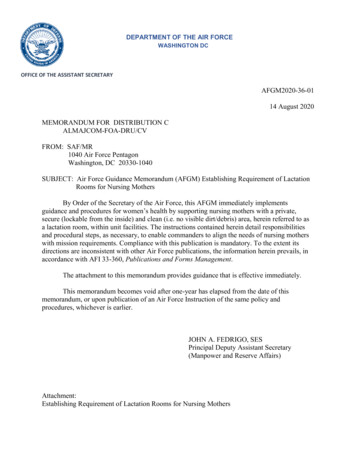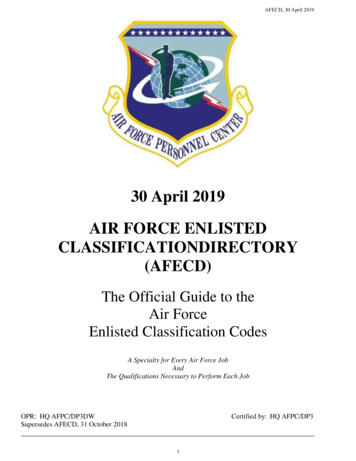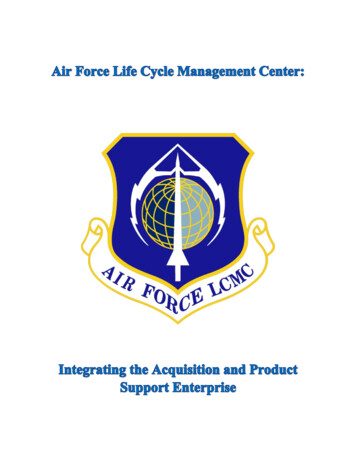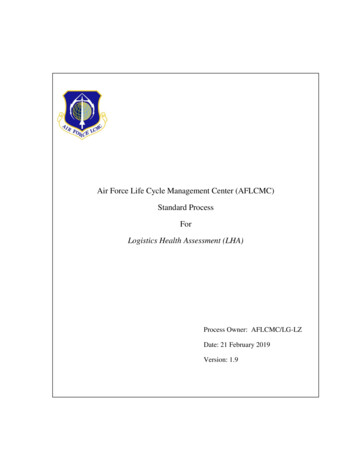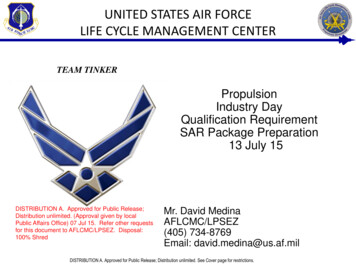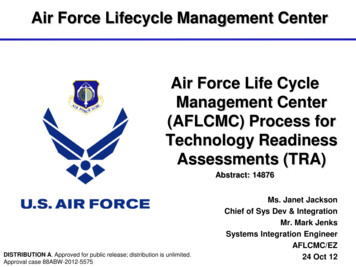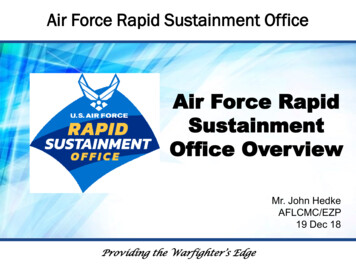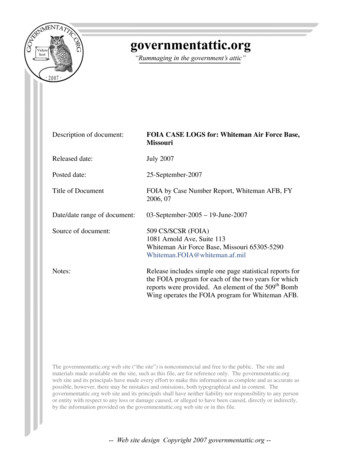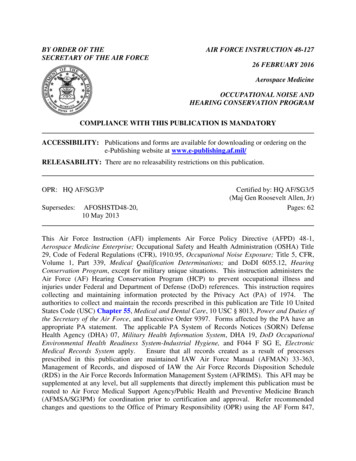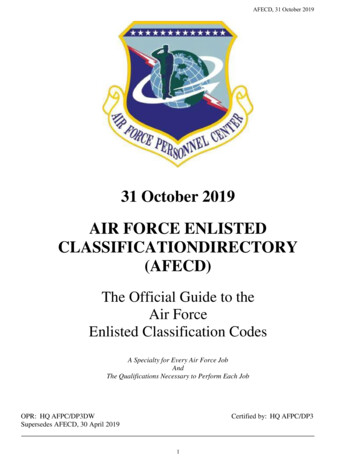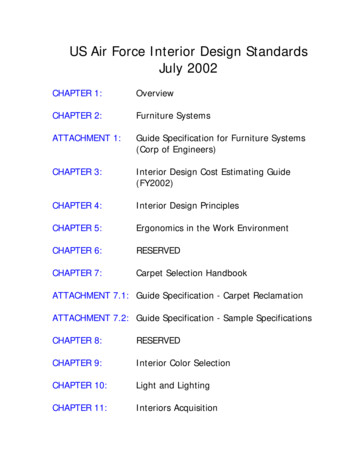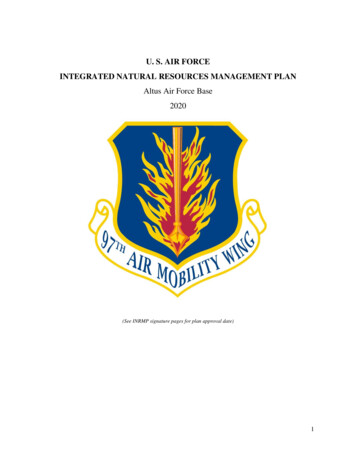
Transcription
U. S. AIR FORCEINTEGRATED NATURAL RESOURCES MANAGEMENT PLANAltus Air Force Base2020(See INRMP signature pages for plan approval date)1
ABOUT THIS PLANThis installation-specific Environmental Management Plan (EMP) is based on the U.S. Air Force’s (AF)standardized Integrated Natural Resources Management Plan (INRMP) template. This INRMP has beendeveloped in cooperation with applicable stakeholders, which may include Sikes Act cooperating agenciesand/or local equivalents, to document how natural resources will be managed. Non-U.S. territories willcomply with applicable Final Governing Standards (FGS). Where applicable, external resources, includingAir Force Instructions (AFIs); AF Playbooks; federal, state, local, FGS, biological opinion and permitrequirements, are referenced.Certain sections of this INRMP begin with standardized, AF-wide “common text” language that addressAF and Department of Defense (DoD) policy and federal requirements. This common text language isrestricted from editing to ensure that it remains standard throughout all plans. Immediately following theAF-wide common text sections are installation sections. The installation sections contain installationspecific content to address local and/or installation-specific requirements. Installation sections areunrestricted and are maintained and updated by the Altus Air Force Base Environmental Element (97CES/CEIE).NOTE: The term ‘97 CES/CEIE’ is used throughout this document to refer to the installation organizationresponsible for the natural resources program.2
TABLE OF CONTENTSABOUT THIS PLAN . 2TABLE OF CONTENTS . 3DOCUMENT CONTROL. 6INRMP APPROVAL/SIGNATURE PAGES . 6EXECUTIVE SUMMARY . 71.0 OVERVIEW AND SCOPE . 81.1 Purpose and Scope . 81.2 Management Philosophy . 81.3 Authority. 91.4 Integration with Other Plans . 101.5 Approvals and Revisions . 102.0 INSTALLATION PROFILE . 112.1 Installation Overview. 122.1.1 Location and Area . 122.1.2 Installation History. 142.1.3 Military Missions . 152.1.4 Surrounding Communities . 172.1.5 Local and Regional Natural Areas . 172.2 Physical Environment . 182.2.1 Climate . 182.2.1.1 Climate Change Projections . 182.2.2 Landforms/Physiography . 202.2.3 Geology and Soils . 202.2.4 Hydrology . 252.2.4.1 Groundwater . 252.2.4.2 Surface Water. 252.2.4.3 Stream Channel Modeling for Climate Change . 252.3 Ecosystems and the Biotic Environment . 262.3.1 Ecosystem Classification . 262.3.2 Vegetation . 272.3.2.1 Climate Change Implications for Vegetation . 282.3.3 Fish and Wildlife. 282.3.3.1 Climate Change Implications for Fish and Wildlife . 292.3.4 Threatened and Endangered Species and Species of Concern . 302.3.5 Wetlands and Floodplains . 312.3.5.1 Climate Change Implications for Wetlands . 342.4 Mission and Natural Resources . 342.4.1 Natural Resources Needed to Support the Military Mission. 342.4.2 Natural Resource Constraints to Mission and Mission Planning . 342.4.2.1 BASH Constraints . 342.4.2.2 Wetlands and Floodplains Constraints . 342.4.3 Climate Change Impacts to the Mission . 373
2.4.4 Land Use . 382.4.5 Current Major Mission Impacts on Natural Resources . 412.4.5.1 Aircraft Operations . 412.4.5.2 Hazardous Materials . 412.4.5.3 Solid Waste . 412.4.5.4 Installation Restoration Program Sites . 422.4.5.5 Air Emissions Sources . 422.4.5.6 Construction Activities . 422.4.6 Potential Future Mission Impacts on Natural Resources . 423.0 ENVIRONMENTAL MANAGEMENT SYSTEM. 424.0 GENERAL ROLES AND RESPONSIBILITIES . 435.0 TRAINING . 446.0 RECORDKEEPING AND REPORTING . 456.1 Recordkeeping . 456.2 Reporting . 457.0 NATURAL RESOURCES PROGRAM MANAGEMENT . 457.1 Fish and Wildlife Management . 467.1.1 Hunting and Fishing as a Management Tool . 467.1.2 Fish and Wildlife Habitat Enhancement . 477.1.3 Migratory Bird Management . 477.1.4 Incorporating Climate Change into Fish and Wildlife Management . 487.2 Outdoor Recreation and Public Access to Natural Resources . 487.2.1 Recreational Hunting and Fishing. 497.2.2 Camping . 507.2.3 Climate Change Implications for Outdoor Recreation. 517.3 Conservation Law Enforcement . 517.4 Management of Threatened and Endangered Species, Species of Concern and Habitats . 527.5 Water Resource Protection . 527.5.1 Surface and Groundwater Protection . 537.5.2 Wetland Protection. 537.6 Grounds Maintenance . 547.7 Forest Management . 557.8 Wildland Fire Management . 557.8.1 Climate Change Implications for Wildland Fire Management . 567.9 Agricultural Outleasing . 567.10 Integrated Pest Management Program . 577.11 Bird/Wildlife Aircraft Strike Hazard (BASH) . 577.12 Coastal Zone and Marine Resources Management . 587.13 Cultural Resources Protection . 587.14 Public Outreach . 587.15 Geographic Information Systems (GIS) . 588.0 MANAGEMENT GOALS AND OBJECTIVES . 599.0 INRMP IMPLEMENTATION, UPDATE, AND REVISION PROCESS . 624
9.1 Natural Resources Management Staffing and Implementation . 629.2 Monitoring INRMP Implementation . 629.3 Annual INRMP Review and Update Requirements . 6310.0 ANNUAL WORK PLANS . 6311.0 REFERENCES . 6611.1 Standard References (Applicable to all AF installations) . 6611.2 Installation References . 6612.0 ACRONYMS . 6812.1 Standard Acronyms (Applicable to all AF installations). 6812.2 Installation Acronyms . 6913.0 DEFINITIONS . 6913.1 Standard Definitions (Applicable to all AF installations) . 6913.2 Installation Definitions . 6914.0 APPENDICES . 72Appendix A. Annotated Summary of Key Legislation Related to INRMP Design andImplementation . 72Appendix B. Methods for Climate Change Projections . 78Appendix C. Climate Analysis Results . 96Appendix D. Hydrology Results . 103Appendix E: Ecosystem Classification and Vegetation . 110Appendix F. Plant Species at Altus AFB. 116Appendix G: Wildlife Species at Altus AFB . 12215.0 ASSOCIATED PLANS . 126Bird/Wildlife Aircraft Strike Hazard (BASH) Plan . 126Integrated Cultural Resources Management Plan (ICRMP) . 126Integrated Pest Management Plan (IPMP) . 126Storm Water Pollution Prevention Plan (SWPPP) . 1265
DOCUMENT CONTROLRecord of Review – The INRMP is updated annually, or more frequently as changes to natural resourcemanagement and conservation practices occur, including those driven by changes in applicable regulations.In accordance with (IAW) the Sikes Act and AFMAN 32-7003, Environmental Conservation, the INRMPis required to be reviewed for operation and effect every five years at the least. The base Natural ResourcesManager (NRM) and 97 CES/CEIE accomplish annual reviews and updates. The installation shall establishand maintain regular communications with the appropriate federal and state agencies. At a minimum, theinstallation NRM (with assistance as appropriate from the Installation Support Team Natural ResourcesMedia Manager) conducts an annual review of the INRMP in coordination with internal stakeholders andlocal representatives of the United States Fish and Wildlife Service (USFWS), state fish and wildlifeagency, and National Oceanic and Atmospheric Administration (NOAA) Fisheries, where applicable, andaccomplishes pertinent updates. Installations will document the findings of the annual review in an AnnualINRMP Review Summary. By signature to the Annual INRMP Review Summary, the collaborating agencyrepresentative asserts concurrence with the findings. Any agreed updates are then made to the document,at a minimum updating the work plans.INRMP APPROVAL/SIGNATURE PAGESThe United States Fish and Wildlife Service (USFWS), Oklahoma Department of Wildlife (ODWC), andthe 97th Air Mobility Wing (97 AMW) by signature of their agency representative, hereby enter into acooperative agreement for the conservation, protection, and management of natural resources present onAltus AFB. This agreement may be modified and amended by mutual agreement of the authorizedrepresentatives of the three agencies. This agreement becomes effective upon the date of the last signatoryand shall cover 5 years or until terminated by written notice, in whole or in part, by any of the partiessigning this agreement.By their signatures below, or an enclosed letter of concurrence, all parties grant their concurrence withand acceptance of the following document.Approving Official:DateMatthew A. Leard, Colonel, USAFCommander, 97th Air Mobility WingAmy LuedersSouthwest Regional Director, U.S. Fish and Wildlife ServiceJ.D. StrongDirector, Oklahoma Department of Wildlife Conservation6
EXECUTIVE SUMMARYThe U.S. Department of Defense (DoD) is responsible under the Sikes Act [Title 16 United States Code(U.S.C.), Section (§) 670a-670f, as amended in 1997] for implementing management strategies to conserveand protect biological resources on its lands. The Sikes Act was enacted into law in 1960 to manage DoDlands for the conservation and wise use of natural resources. The Sikes Act was amended in 1997 to mandatethe development of an Integrated Natural Resources Management Plan (INRMP) at DoD installations.Requirements of the Sikes Act that are implemented by this INRMP include Department of DefenseInstruction (DODI) 4715.03, Natural Resources Conservation Program (18 March 2011), Air Force PolicyDirective (AFPD) 32-70, Environmental Considerations in Air Force Programs and Activities (30 July2018), and Air Force Manual (AFMAN) 32-7003, Environmental Conservation (20 April 2020).The Headquarters Air Force’s Directorate of Civil Engineers (A
Apr 29, 2016 · 6 DOCUMENT CONTROL Record of Review – The INRMP is updated annually, or more frequently as changes to natural resource management and conservation practices occur, including those driven by changes in applicable regulations. In accordance with (IAW) the Sikes Act and AFMAN 32-7003, Environmental Conservation, the IN

